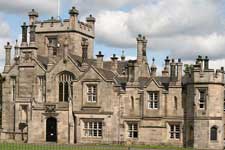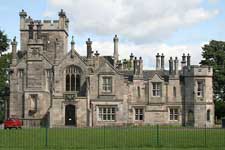Muirhouse
Location
Muirhouse is situated towards the west of the Granton area, near to Silverknowes. Historically, it was in the parish of Cramond. It is near two other large houses, Silverknowe and Broomfield.
Owners
The estate of Muirhouse is said to have been a hunting seat of the Scottish kings. In 1316 it is recorded as having been owned by Sir William Oliphant of Abergaldy, and his family kept it for the next three hundred years before the fifth Lord Oliphant sold it in 1616 to Sir William Oliphant of Newton, a Court of Session judge. He died in 1628 and the property passed to his son, Sir James Oliphant, also a judge. He ceased to be a judge after murdering his gardener. His son, also Sir James Oliphant, then became owner but he stabbed his mother to death and fled the country.
Muirhouse was then owned by John Hamilton, an apothecary, John Denholm and James Hunter, an advocate. James Hunter sold it in 1697 to Robert Watson of Damhead, a merchant in Edinburgh, whose grandson General Watson in turn sold it in 1776 to William Davidson, a merchant in Rotterdam. He gave his name to Davidson’s Mains, previously called Muttonhole. When he died in 1794 he left the Muirhouse estate to his nephew Dr Thomas Randall, minister of Lady Yester’s Church and later Tollbooth Church (both in Edinburgh), who adopted the name Davidson. He became the proprietor of Hatton Estate near Ratho in 1796, and the estate remained in the ownership of the family until 1870, when it was sold to the Earl of Morton. Captain Davidson became known for his generosity to charity. When he died in 1827 at the age of 80 his son became the owner of the estate.
By 1898, the property was owned by Henry Davidson. His brother, Dr Randall Davidson![]() , was Archbishop of Canterbury between 1903 and 1928.
, was Archbishop of Canterbury between 1903 and 1928.
Henry Davidson employed James Sharp as gardener in 1898, and he remained in that position with three other families. From 1932 to 1948, Mrs W Munro was tenant of the property.
Architecture
The first recorded building was an old mansion built around 1670, of which two round towers survived for many years after most of the building was demolished. These towers eventually became ruinous and were pulled down in 1954 by Edinburgh Corporation. The towers are recorded as having been 50 feet high.
The present building was built around 1830, and was approached from the west and the east by tree-lined avenues. It has been described (by Historic Scotland![]() ) as dating from 1832, Tudor, an asymmetrical 2-storey building with a square tower, and built of ashlar, finely detailed, with frescoes by Zephaniah Bell (1832) in the drawing room. (Ashlar is smooth-dressed squared stonework with fine joints). It is a Category A listed building.
) as dating from 1832, Tudor, an asymmetrical 2-storey building with a square tower, and built of ashlar, finely detailed, with frescoes by Zephaniah Bell (1832) in the drawing room. (Ashlar is smooth-dressed squared stonework with fine joints). It is a Category A listed building.
The adjacent stables are also listed, and are said to have been designed by Richard and Robert Dickson, also in 1832. It is not clear whether they were also the architects of the house itself. There is much more information about the stables at the Historic Scotland website![]() .
.
Recent History
During World War II, the gardens at Muirhouse supplied produce to raise money for the Prisoner of War Fund. The garden was removed during the 1950s to allow the construction of a road from Muirhouse to Silverknowes, which became Marine Drive. Muirhouse is near the junction of West Shore Road and Marine Drive.

